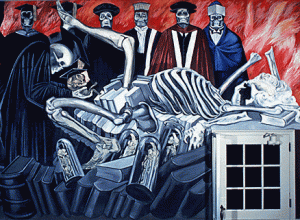Gods of the Modern World
1/13/17
In 1932, José Clemente Orozco began painting The Epic of American Civilization. After two years, Orozco completed the mural, which soon became a favored work of art for the Dartmouth students. Orozco was not intentionally planning to come to Hanover until Artema S. Packard and Churchill P. Lathrop, Dartmouth art history professors, approached him about the possible art project (Orozco at Dartmouth 3). After the mural was completed, the Gods of the Modern World piece became controversial because it expressed education as “useless knowledge” and ignorant of the contemporary state of the world (Orozco at Dartmouth 11). Orozco’s purpose in creating this mural is not to cause an instant change in what is education, but he wants the education system to become aware of the harm that comes to the world if one only focuses on being a professional at math or writing when there are internal and external conflicts in the country.
The title of the panel, Gods of the Modern World, expresses an uncanny theme (Figure 1). Although the “Gods” are not actual deities, the Gods Orozco refers to are the professionals in a certain area of study. In the mural, the deities are represented by skeletons. When one looks upon the professionals, one sees flesh and not the bones of a skeleton. Bringing out the bones instead of the flesh, Orozco succeeds in capturing the unimaginable consequence of how knowledge in society ultimately stays put. Although knowledge is the factor to select whether one is successful or not, from the moment one is born, the expectation is to become a professional in a certain field. Despite this, education remains the same. There is no expansion because people are set on believing facts now rather than on the “unseen.” Just as the title of the piece expresses the respect one has towards the professionals, Orozco also implies a decrease in the use of imagination in the sense of religion due to the title of the mural: Gods of the Modern World. Everything modern day is being based on science rather than on people’s beliefs as shown by the books under the cases of the still born babies. The population no longer sees God as being the creator and sole ruler of the world because, instead of God being “imaginary,” people rely on those with credentials as the experts and “god-like” people who can tell what is correct and wrong.

The first thing that one notices from the panel Gods of the Modern World is the skeleton that is horizontal to the wall due to its large size. In the beginning, the skeleton had white hair similar to that of the men in the 18th century, but when one moves towards the left of the mural, one notices the way the feet are spread apart. When women are giving birth, they spread their legs similar to the position of the skeleton in the mural. The doctor on the left is carrying a tiny baby skeleton representing a still birth scenario. The baby is not an actual child, but represents the idea of knowledge due to the graduation cap and the other skeletons dressed in academic garb. The mother gave birth to a stillborn baby, symbolizing the birth of “useless knowledge”. Looking towards the bottom of the panel, there are even more tiny baby fetuses in clear-like containers. These baby fetuses suggest the inability for the academy to spread knowledge when it is just set to disintegrate (Orozco at Dartmouth 11). Although skeletons were the main objects of the panel, the fire in the background also becomes an attraction to critics. The use of fire is also seen in Cortez and the Cross (Figure 2). Fire in this piece is used to reveal the destruction that Cortez brought to the new land. Despite fire being seen all over, Cortez ignores it, just as he sent his ships to be burned to stay in the new land and not go back to where they lived before. Similar to the panel Gods of the Modern World, Cortez is portrayed as a deity ignorant of what he leaves behind. Therefore, Orozco also utilizes fire in Gods of the Modern World to symbolize the ignorance that “professionals” have due to not being educated about their surroundings, only focused on what lays ahead of them in their career (Orozco at Dartmouth 10).

From the skeletons to the fire in the background, the viewer becomes captivated by the sinister mood incorporated into the mural. Orozco conveys an eerie feeling of what lays ahead of education after he expresses in his mural the rough truth of not possessing knowledge of one’s surroundings: it leads to the “useless knowledge” one encounters in the academy. With the mood set in the mural, it brings the public to ask themselves why they are seeking higher education in a certain field. Education does not need to measure one’s intelligence nor does it mean that it has to have set rules. As Orozco portrays education as useless, education can be improved or become a positive light for the ones who want to educate themselves if they want to. Education has to be knowledge one wants to learn and not knowledge that has no liberty to change from one individual to the next. From being aware of conflicts abroad to knowing how to fish, knit, draw, etc. can be helpful to the society instead of just focusing on the careers that will “push” people forward- become wealthy. Orozco is criticizing education in society because it doesn’t allow people to be creative about who they want to be.
Source Cited
Orozco at Dartmouth: The Epic of American Civilization. Dartmouth College: Trustees of Dartmouth College, 2012.